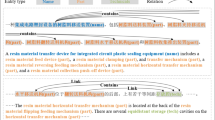Abstract
Entity linking is a key step for automatic question and answering with knowledge graph. It has broad application prospects in Natural Language Processing, Information Retrieval and other fields. This paper constructed an entity linking model based on candidate features. Firstly, it proposed a candidate entities generation algorithm that combines knowledge base matching and word vector similarity calculation and then put forward a suitable entity disambiguation algorithm for different candidate entity generation features, so as to the linked entity is matched to the correct knowledge base entity. We did experiments on the Chinese Weibo Entity Linking data set released by NLPCC in 2013. The results showed that our model can achieve better F1 scores and recall rate than the traditional entity linking methods.




Similar content being viewed by others
References
Bunescu R, Pasca M (2006) Using encyclopedic knowledge for named entity disambiguation. In: Proceedings of EACL, vol. 6
Cucerzan S (2007) Large-scale named entity disambiguation based on wikipedia data. In: Proceedings of EMNLP-CoNLL, pp 708–716
Dredze M, McNamee P, Rao D, Gerber A, Finin T (2010) Entity disambiguation for knowledge base population. In: proceedings of COLING, pp 277–285
Fader A, Soderland S, Etzioni O, Center T (2009) Scaling Wikipedia-based named entity disambiguation to arbitrary web text. In: Proceedings of Wiki-AI at IJCAI, pp 21–26
Han X, Sun L, Zhao J (2011) Collective entity linking in web text: a graph-based method. In: SIGIR’11, Proceedings of the 34th international ACM SIGIR conference on research and development in information. https://doi.org/10.1145/2009916.2010019
Kulkarni S, Singh A, Ramakrishnan G, Chakrabarti S (2009) Collective annotation of wikipedia entities in web text. In: KDD ’09, Proceedings of the 15th ACM SIGKDD international conference on Knowledge discovery and data mining. pp 457–466. https://doi.org/10.1145/1557019.1557073
Medelyan O, Witten IH, Milne D (2008) Topic indexing with Wikipedia. In: Proceedings of AAAI workshop on wikipedia and artificial intelligence: an Evolving Synergy. AAAI Press, Chicago, USA, pp 19–24
Melucci M (2009) Vector-Space Model. In: LIU L, ÖZSU MT (eds) Encyclopedia of database systems. Springer, Boston, MA. https://doi.org/10.1007/978-0-387-39940-9_918
Mihalcea R (2005) Unsupervised large-vocabulary word sense disambiguation with graph -based algorithms for sequence data labeling. In: Proceedings of human language technology conference and conference on empirical methods in natural language processing, Vancouver, pp 411–418
Mihalcea R, Csomai A (2007) Wikify!: linking documents to encyclopedic knowledge. In: CIKM’07, Proceedings of the sixteenth ACM conference on conference on information and knowledge management, pp 233–242. https://doi.org/10.1145/1321440.1321475
Mikolov T, Chen K, Corrado G, Dean J (2013) Efficient estimation of word representations in vector space. arXiv: 1301.3781
Milne D, Witten IH (2008) Learning to link with Wikipedia. In: CIKM’08, Proceedings of the 17th ACM conference on Information and knowledge management, pp 509–518. https://doi.org/10.1145/1458082.1458150
Navigli R, Martelli F (2019) An overview of word and sense similarity. Nat Lang Eng 25(6):693–714. https://doi.org/10.1017/S1351324919000305
Navigli R, Velardi P (2005) Structural semantic interconnections: a knowledge-based approach to word sense disambiguation. IEEE Trans Pattern Anal Mach Intell 27(7):1075–1086
Nedelchev R, Chaudhuri D (2020) End-to-End entity linking and disambiguation leveraging word and knowledge graph embeddings. arXiv:2002.11143 [cs.CL]
NLPCC [Online] (2013). http://tcci.ccf.org.cn/conference/2013/dldoc/ev04.pdfAccessed 15–19 Nov 2013
Pedersen T (2001) A decision tree of bigrams is an accurate predictor of word sense. In: Proceeding of the second annual meeting of the north American chapter of the association for computational linguistics, Pittsburgh, pp 79–86
Rosales-Méndez H, Poblete B, Hogan A (2018) What should entity linking link?. Disponible en http://repositorio.uchile.cl/handle/2250/169429
Sevgili O, Shelmanov A (2020) Neural entity linking: A survey of models based on deep learning. arXiv:2006.00575 [cs.CL]
Zhang W, Su J, Tan Chew Lim, Wang WT (2010) Entity linking leveraging automatically generated annotation. In: Proceedings of the 23rd COLING, pp 1290–1298
Zhao Y, Jiang H, Wang X (2010) Minimum edit distance-based text matching algorithm. In: Proceedings of the 6th international conference on natural language processing and knowledge engineering (NLPKE-2010), Beijing, pp 1–4. https://doi.org/10.1109/NLPKE.2010.5587852
Zheng Z, Li F, Huang M, Zhu X (2010) Learning to link entities with knowledge base. In: The proceedings of NAACL, pp 483–491
Zhou Y, Nie L, Rouhani-Kalleh O, Vasile F, Gaffney S (2010) Resolving surface forms to wikipedia topics. In: Proceedings of the 23rd COLING, pp 1335–1343
Acknowledgements
The authors are grateful to the editors and reviewers for their helpful comments and suggestions. This research is partially supported by National Social Science Foundation project (17BXW065), National Key R&D Program of China (2018******01) and Science and Technology Research project of Henan province (172102310628).
Author information
Authors and Affiliations
Corresponding author
Additional information
Publisher's Note
Springer Nature remains neutral with regard to jurisdictional claims in published maps and institutional affiliations.
Rights and permissions
About this article
Cite this article
Li, D., Fu, Z. & Zheng, Z. An entity linking model based on candidate features. Soc. Netw. Anal. Min. 11, 50 (2021). https://doi.org/10.1007/s13278-021-00761-z
Received:
Revised:
Accepted:
Published:
DOI: https://doi.org/10.1007/s13278-021-00761-z




